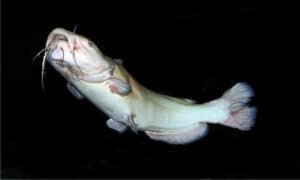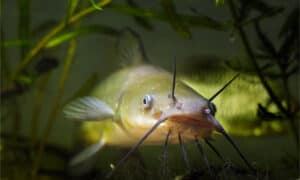Blue catfish (scientific name: Ictalurus furcatus) are a freshwater fish species native to the Ohio, Mississippi, and Missouri River basins in the U.S.
Despite their native range, this fish species has been introduced to various water bodies nationwide for sport fishing and aquaculture purposes. One area where blue catfish have been introduced is California. Here, they have established self-sustaining populations and have become an invasive species.
Introducing blue catfish to California has raised concerns about their potential impacts on native aquatic species and ecosystems and the economic and social implications for anglers and other stakeholders.
Today, we provide an overview of blue catfish in California. We delve into their history in the state, physical characteristics, diet, predators, ecological impacts, and management efforts. We’ll also discover the largest blue catfish ever caught in California!
The Largest Blue Catfish Ever Caught in California
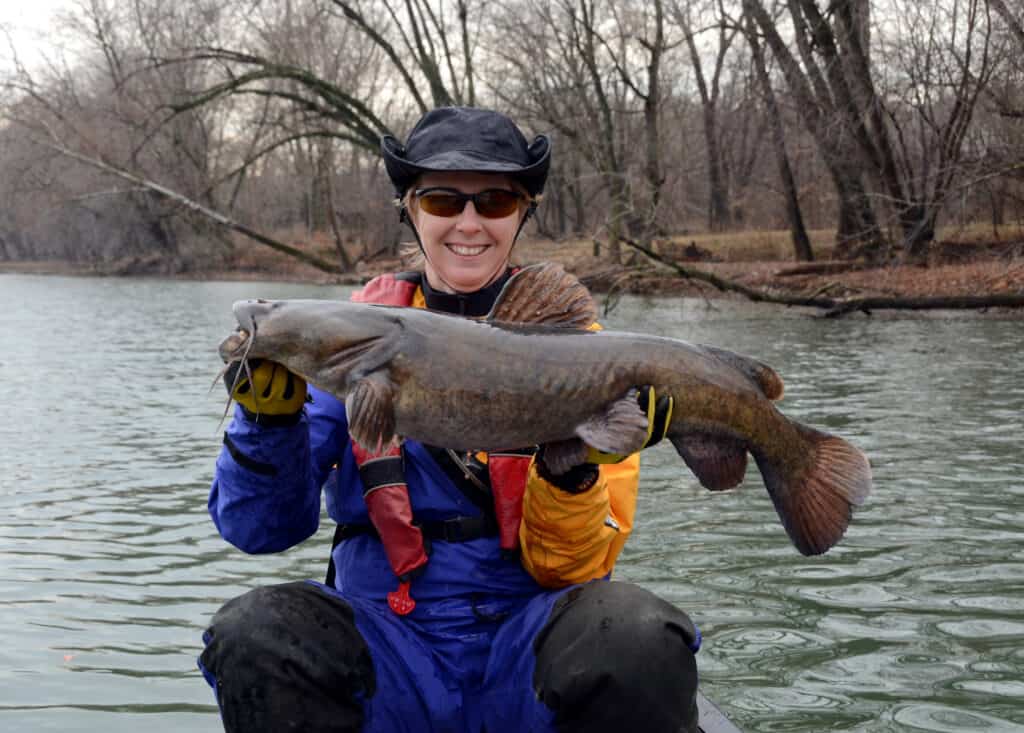
The largest blue catfish ever caught in California weighed 113 lbs. 5 oz.
©M. Huston/Shutterstock.com
The largest blue catfish ever caught in California weighed 113 lbs. 5 oz. Angler Steve Oudomsouk caught the 57-inch long fish at the San Vicente Reservoir on July 24, 2008. The fish, whose girth was 39 inches, was caught by bait.
The Largest Blue Catfish Ever Caught in the World
According to the International Game Fish Association (IGFA), the largest blue catfish ever caught weighed 143 pounds. The fish was 57 inches long and had a girth of 47 inches. Angler Richard Anderson caught the fish in the Kerr Lake Reservoir in Virginia in 2011 using a chunk of gizzard shad as bait. The catch was confirmed and certified by the IGFA, which maintains records for both freshwater and saltwater fish.
Physical Characteristics of Blue Catfish
Blue catfish are large freshwater fish that can grow to over 100 lbs. and exceed 5 ft. in length. Their slate blue coloration and deeply forked tail fin distinguish them from other catfish species.
Size and Weight
Blue catfish exhibit sexual dimorphism, with males typically growing larger than females. In California, adult males can reach weights of 50 lbs. or more, while females usually don’t exceed 30 lbs.
Body Shape and Coloration
In addition to their distinctive blue coloration, blue catfish have a flattened head and a long, cylindrical body. A layer of mucus protects them against parasites and disease. The dorsal fin is located towards the back of the body and comprises a series of sharp spines.
Fin Structure
Blue catfish have a deeply forked tail fin, giving them a powerful swimming ability. The pectoral fins are large and fan-shaped and are used for stability and maneuvering. The anal and pelvic fins are located on the underside of the body and are used for braking and steering.
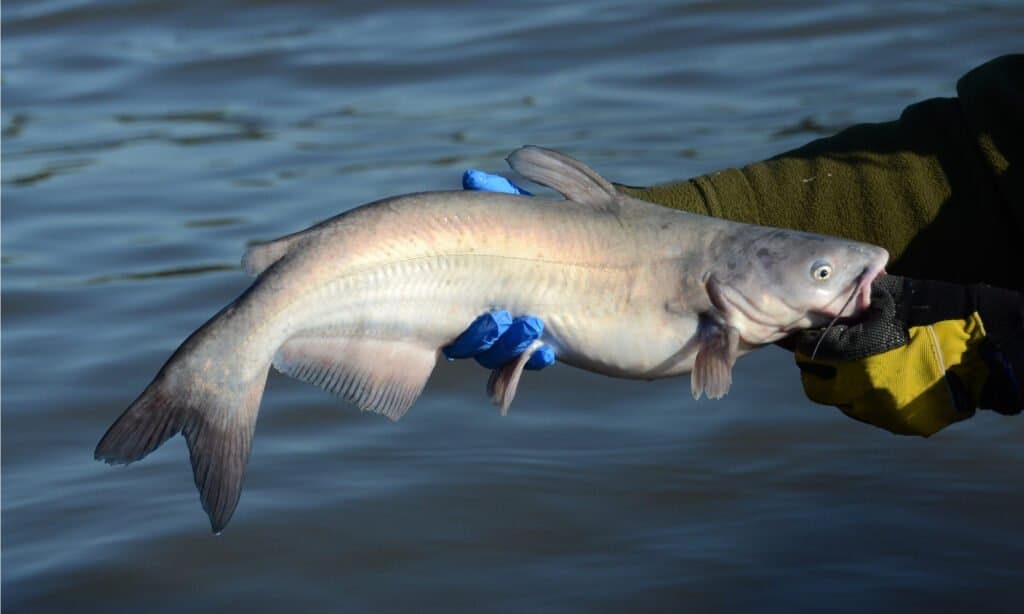
The slate blue coloration and deeply forked tail fin distinguish blue catfish from other catfish species.
©M Huston/Shutterstock.com
History of Blue Catfish in California
Introduction and Early Establishment
Blue catfish were first introduced to California in the 1960s for sport fishing purposes in several reservoirs and lakes in the San Joaquin Valley. These early introductions were unsuccessful. As a result, blue catfish didn’t establish in California until the 1980s, when larger fingerling numbers were stocked in several lakes and reservoirs.
The initial stocking of blue catfish in California was intended to provide additional recreational opportunities for anglers and diversify fishery resources. But blue catfish weren’t well suited for California’s aquatic environments, which are generally colder and less productive than their native range in the southeastern United States.
Spread and Population Growth
Despite these challenges, blue catfish populations began to establish in several water bodies throughout the state, including:
- San Francisco Bay
- Colorado River system
- Sacramento-San Joaquin Delta
The success of these introductions was likely the species’ high reproductive potential and adaptability to a range of environmental conditions.
Current Distribution and Abundance
Today, blue catfish thrive in numerous water bodies throughout California, including several large reservoirs and river systems. The species is particularly abundant in the Sacramento-San Joaquin Delta, where it makes 75% of the total fish biomass.
The exact distribution and abundance of blue catfish in California is difficult to determine. That’s because fisheries surveys and monitoring programs often do not specifically target the species often do not specifically target the species.
Blue Catfish Diet
Blue catfish are opportunistic predators that feed on various prey, including:
- Fish
- Crustaceans
- Mollusks
They’re often called “bottom feeders” due to their feeding habits, which typically involve scavenging along the bottom of the water column.
Natural Prey
In their native range, blue catfish feed primarily on fish such as:
They also consume various crustaceans, including crayfish and shrimp. Blue catfish feed on freshwater mussels in some areas, negatively impacting these important ecological resources.
Prey in California
In California, blue catfish feed on various native and non-native fish species, including:
- Threadfin shad
- Common carp
- Striped bass
They also consume crayfish and other invertebrates commonly found in California’s freshwater systems. The high abundance of blue catfish in some areas has raised concerns about their potential impacts on native fish populations and the overall ecological balance in the state’s water bodies.
Feeding Behavior
Blue catfish are nocturnal feeders who are most active at night. They use their highly sensitive barbels around the mouth to detect and locate prey. Once a suitable prey item is located, blue catfish use their large mouths and sharp teeth to capture and consume their food.
Blue Catfish Predators in California
Despite their large size and powerful swimming ability, blue catfish have numerous natural predators in California’s freshwater systems.
Native Predators
In their native range, blue catfish have evolved to deal with many predators, including larger fish species such as alligator gar and snapping turtles. But in California, blue catfish face a different suite of predators.
Native predatory fish species such as largemouth bass, channel catfish, and black crappie feed on juvenile blue catfish. In contrast, birds such as ospreys and eagles prey on adult fish.
Non-Native Predators
Introducing non-native fish species in California’s freshwater systems has also created new challenges for blue catfish. For example, the predatory striped bass, introduced to the Sacramento-San Joaquin Delta in the 1870s, preys on adult blue catfish.
Human Impacts
In addition to natural predators, blue catfish also face threats from human activities such as:
- Overfishing
- Habitat degradation
- Pollution
Overfishing can reduce blue catfish populations. Similarly, habitat degradation and pollution can reduce the quality fish’s fish’s habitat, making it harder for them to survive and thrive.
Conservation efforts, such as habitat restoration and fisheries management, can help to mitigate these impacts and promote the long-term health of blue catfish populations in California.

The predatory striped bass, introduced to the Sacramento-San Joaquin Delta in the 1870s, preys on adult blue catfish.
©Pelow Media/Shutterstock.com
Ecological Impacts of Blue Catfish in California
As a non-native species in California’s freshwater systems, blue catfish can significantly impact the ecology of these environments.
Competition with Native Species
One primary concern with blue catfish in California is their potential to outcompete native fish species for resources such as food and habitat. In addition, blue catfish are voracious predators, and their presence in some areas has been associated with declines in native fish populations.
Alteration of Food Webs
In addition to competition with native species, blue catfish can alter the structure and function of freshwater food webs. By consuming various prey, including non-native fish species, blue catfish can change the relative abundance of different organisms within these ecosystems. In addition, this can affect other species that rely on the organisms for food or habitat.
Impacts on Endangered Species
Blue catfish can also directly impact threatened species in California’s freshwater systems. For example, the delta smelt, a small fish species listed as endangered under the Endangered Species Act, is a prey item for blue catfish. The presence of blue catfish in areas where delta smelt occurs could therefore contribute to the decline of this already imperiled species.
Management Efforts for Blue Catfish in California
Mitigation Efforts
Several management strategies have been proposed and implemented to mitigate the potential ecological impacts of blue catfish in California. These include:
- Increased monitoring and control of blue catfish populations
- Promotion of native species restoration and conservation efforts
- Developing education and outreach programs to increase public awareness of the impacts of non-native species on freshwater ecosystems
Let’s find out more about each strategy.
Fishing Regulations
One primary tool used to manage blue catfish populations in California is fishing regulations. The California Department of Fish and Wildlife has established bag and possession limits and size limits for blue catfish in some areas. These regulations are designed to promote sustainable fishing practices and prevent overexploitation of blue catfish populations.
Removal Programs
Implementing removal programs can be useful to control blue catfish populations. These programs can involve a targeted removal of adult fish or techniques such as electrofishing to capture large numbers of fish at once.
Public Education and Outreach
Public education and outreach programs can also play a key role in managing blue catfish populations in California. By increasing public awareness of the potential impacts of non-native species on freshwater ecosystems, these programs can help to reduce the introduction and spread of blue catfish and other invasive species.
Habitat Restoration and Native Species Conservation
To promote the long-term health of freshwater ecosystems in California, efforts are underway to restore degraded habitats and promote the conservation of native species. By restoring habitats and promoting the recovery of native fish species, these efforts can help to reduce the impacts of blue catfish and other non-native species on freshwater ecosystems.
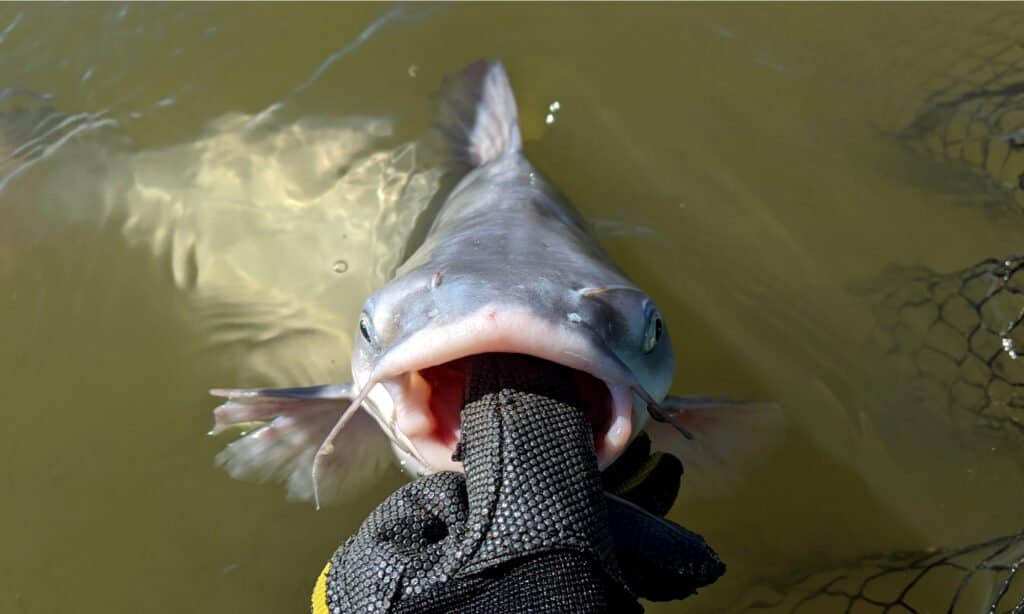
The California Department of Fish and Wildlife has established bag and possession limits and size limits for blue catfish in some areas.
©M Huston/Shutterstock.com
Challenges and Opportunities
Managing blue catfish in California presents a number of challenges and opportunities for freshwater ecosystem conservation and management.
Challenges
Among the primary challenges of managing blue catfish in California is their ability to rapidly reproduce and spread in freshwater environments. This can make it difficult to control their populations, especially in areas where they have already become established.
Opportunities
Controlling blue catfish populations can help reduce this non-native species’ ecological impacts on water ecosystems. This can benefit native fish species and other aquatic organisms.
Additionally, developing and implementing management strategies for blue catfish can provide opportunities for collaboration between government agencies, researchers, and other stakeholders interested in conserving and managing freshwater resources.
Research Needs
To effectively manage blue catfish populations in California, there is a need for ongoing research to understand better their ecology, behavior, and potential impacts on freshwater ecosystems.
This research can help inform the development of management strategies and improve our ability to monitor and control blue catfish populations.
Key Takeaways
The presence of blue catfish in California’s freshwater systems presents several challenges and opportunities for freshwater ecosystem conservation and management.
While these non-native fish species can negatively impact native fish populations and freshwater ecosystems, developing and implementing management strategies can provide opportunities for collaboration among stakeholders and promote the long-term health of freshwater ecosystems.
Efforts to manage blue catfish populations in California can be enhanced through ongoing research, public education and outreach, and the development of effective management strategies. By promoting sustainable fishing practices, controlling non-native species populations, and restoring degraded habitats, we can work towards conserving and managing freshwater resources in California.
Ultimately, effectively managing blue catfish populations will require a multifaceted approach that addresses the ecological and social dimensions of freshwater ecosystem conservation and management.
Where Is San Diego, California Located On A Map?
San Vicente Reservoir is located 25 miles northeast of San Diego, which is located in southern California. The state of California is located in the Western United States along the Pacific Coast. It is bordered by the Pacific Ocean to the west, Oregon to the north, Arizona, and Nevada to the east, and the Mexican state of Baja California to the south.
Here is San Diego, California on a map:
The photo featured at the top of this post is © M Huston/Shutterstock.com
Thank you for reading! Have some feedback for us? Contact the AZ Animals editorial team.




